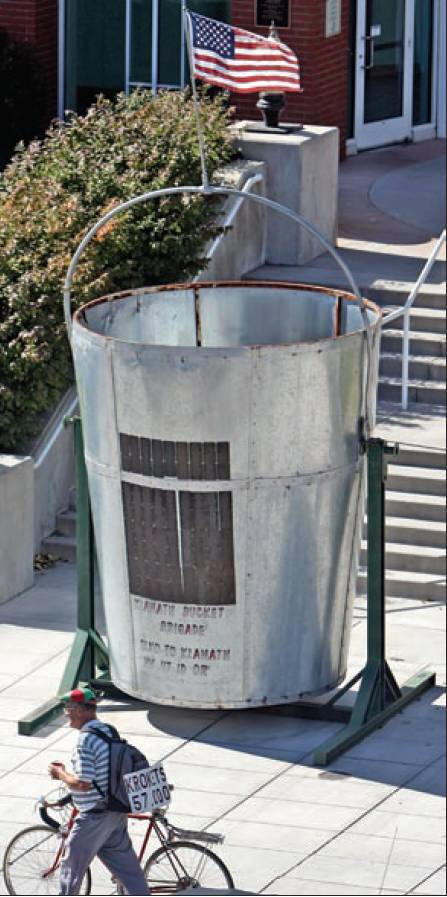|
www.heraldandnews.com
The of battle the Bucket
Commissioners,
Residents disagree on what to do with water crisis symbol
 Herald
and News by Ryan Pfeil, 9/19/08 Herald
and News by Ryan Pfeil, 9/19/08
H&N photo by Andrew Mariman The bucket memorializing the
Klamath Bucket Brigade is considered an eyesore by some, and an
important historic reminder by others.
For many Klamath Basin residents, a larger-than-life bucket in
front of the Klamath County Government Center is a symbol of unity
in a time of crisis. For others, it is an eyesore.
But talk of moving the bucket — a memorial of the 2001 water
crisis when the federal government shut off irrigation water to
Klamath Basin farmers to protect fish — meets resistance from
farmers and community leaders.
The bucket was transported from Elko, Nev., to Klamath Falls as
part of the Klamath Bucket Brigade to support Klamath Basin
farmers.
But there are some residents who don’t believe the bucket
represents all of the Klamath Basin community and should be moved,
perhaps to the Klamath County Museum, where it can be viewed as a
part of history.
They were among 75 percent of respondents to a Herald and News
blog about the bucket who said it should be moved, or even
scrapped.
Klamath County commissioners told the Herald and News this week
they wouldn’t consider moving it until ongoing water issues are
resolved.
S ome blog respondents called the bucket an important historical
monument, but think it should be moved to a more appropriate spot
for safety reasons.
“I fear that someone or something could get trapped inside it,”
one respondent said. “Does it have a screen over the top?”
Others said the bucket was a symbol of political divisiveness and
should be gotten rid of completely.
“The bucket is a reminder to many of us of the near riots that
were being provoked by extremist locals and out-of-town right wing
agitators,” a respondent said. “It shouldn’t be on any public
property. The best ‘placement’ for the bucket is the scrap yard.”
And some viewed its location as a political move on the part of
local government.
“Our county commissioners have kept it there to gather votes,” a
respondent said. “But many of us regard it as an eyesore that
detracts from the attractive appearance of a government building
paid for by all of us.”
Visible location, constant reminder
Klamath Falls Mayor Todd Kellstrom agreed that moving the bucket
might be appropriate, but not because the piece is unsightly.
“I wouldn’t call it an eyesore by any stretch of the imagination,”
he said. “I don’t think we should discard that important symbol of
history.”
Kellstrom said if the memorial were moved, the museum would be an
appropriate spot.
Tulelake farmer Scott Seus agrees that if moving the bucket is the
only option, then its new location should be a prominent gathering
place in the community. He suggested the Klamath County
Fairgrounds.
“I still want to see it somewhere where it’s a remembered piece,”
Seus said. “Perhaps it needs to be in a different location, but it
still needs to be somewhere prominent where it stands out as a
constant reminder.”
Seus thinks the current location is still appropriate because of
the Bureau of Reclamation’s impact on county government.
“It was government created issues,” Seus said. “Therefore, maybe
it is appropriate being there.”
Klamath County Museums manager Todd Kepple said if the bucket were
moved, the museum would be a good spot for it.
“We are prepared to receive it if that’s what the commissioners
were to decide,” he said. “It’s certainly an important piece of
local history.”
What the commissioners think
Klamath County Commissioner Al Switzer feels the bucket should be
left where it is until negotiations over water use are fully
resolved.
“That’s what it’s there for,” Switzer said.
Switzer has not heard too many people call the bucket unsightly,
but he has heard it called divisive. He wondered whether those who
called it a community eyesore fully understood what the bucket
symbolized.
Commissioners Bill Brown and John Elliott agreed, saying the
bucket should not be moved until there is a fair resolution. Brown
was vice president of the Bucket Brigade, an organization that
helped get the bucket placed in its prominent location.
“The purpose of that bucket is very significant,” Brown said. “It
showed the solidarity of the people during the water crisis.”
“A bucket is effective when both sides of the handle are firmly
attached, and the bucket is in balance,” Elliott said. “Until the
demand and supplies and everything are in balance, I feel the
bucket should stay right where it is.”
Elliott does not think the bucket is an eyesore.
“A visual embarrassment to the community is thousands of acres of
dry fields,” he said.
|

